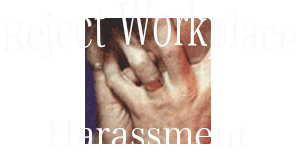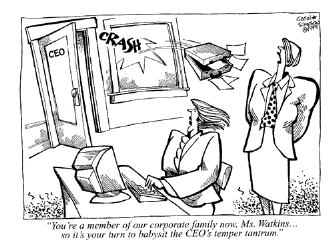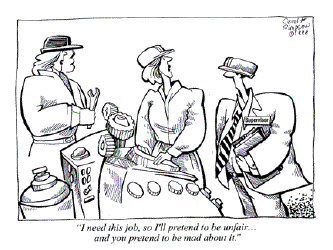Bullying at Work is Illegitimate and Damages Productivity
Please take the time to read the following two paragraphs and give some thought to their significance and importance to everybody both as citizens of a democratic nation and as working people within the organization which employs them...
All Human Beings are born free and equal in dignity and rights. They are endowed with reason and conscience and should act towards one another in a spirit of brotherhood.
No one shall be subjected to arbitrary interference with his privacy, family, home or correspondence, not to attacks upon his honor and reputation. Everyone has the right to protection of the law against such interference or attacks
Articles 1 and 12 Universal Declaration of Human Rights 1948.
Given the above as an agreed starting point for a minimum standard of rights to every human being, can there really be any justification for the way in which many employees across the world are being treated in their workplaces by either their managers or other employees?
Perhaps you can remember from your childhood, a time when you were bullied at school? You may remember the fear and the anxiety that your treatment caused? Well, as confirmed by the ever increasing body of research, the unfortunate truth is that the emotions you felt back at that time are being felt at this moment by literally millions of working people right across the world in nations both East and West.
How significant is the problem?
As far as the UK is concerned, research for the BBC carried out by Charlotte Rayner PhD of Staffordshire University Business School and Prof. Cary Cooper of the Manchester School of Management (UMIST) has concluded that a staggering 53% of their sample reported having been bullied at work and 77% of respondents reported having been witnesses to such bullying (Leadership Organization Development Journal 1997 p 211-214). These statistics appear to be consistent with the growing body of research available at this time.
In the United States, a survey of 600 full time American workers found that some 19% reported being subject to harassment whilst a further 7% reported threats of physical harm (North West National Live 1993). Other studies in the US however such as those by Lorleigh Keashley of Wayne State University, Detroit and an on line study by Gary and Ruth Namie of Bully Busters have found higher ratios of such harassment.
But what is bullying at work?
Harassment can take the form of physical, verbal or non verbal conduct which is unwanted by the individual target. Conduct which makes the individual feel harassed is harassment even though that may not have been the intention of the harasser. In certain circumstances, harassment can be unlawful and can result in legal proceedings being taken against the harasser and often the employer as well who will be vicariously liable for the actions of any employee who is acting in the course of his or her employment.
Bullying is slightly different as it is intentional. Each incident may not seem significant to the objective observer when taken in isolation however it is
important to recognize that there is a cumulative effect and each incident is in effect building on the last.
Bullying can be defined as the persistent use of offensive behavior which gradually undermines a persons self esteem and confidence. Whilst bullying does not include constructive criticism of behavior or performance by line managers or supervisors upwards, it should be recognized that such criticism can often be used as a way to further undermine the confidence of a person who is already under the cumulative effect of harassment and that such poor performance may well be a direct result of that harassment.
The Common Myth in Industrial Relations.
There is a popular myth in the business world to the effect that employees are inherently lazy and need a supervisor behind them cracking the whip in order to increase production and thereby increase profits. Whilst it is true that an organized system of working with some form of strategic planning will help in most working environments, abusive and arbitrary styles of management cross the thin dividing line between effective and abusive management. A manager who shouts at and/or humiliates his/her work force will be building up resentment and hostility in those persons who work for them in a way that they never imagined possible.
Bullying at work is in nobodies interest. Both employers and employees are in a lose: lose scenario as a result of bullying in the workplace. The employer can expect significantly higher sickness rates, high employee turnover with the resultant high cost of training and retraining, exceedingly low work force morale and poor industrial relations whilst the employees can expect higher levels of stress, a miserable working environment and even premature death due to stress related illness such as heart disease and certain forms of cancer which have been linked to stress. Indeed, even suicide and murder are far from unknown in workplaces which have bullies in the work force!
Research from Leicester University Law School records significantly higher levels of white collar crime and predictably low levels of confidence in the employer leading to feelings of disenfranchisement in abusive work environments. Greenberg Scott (1996) suggest that many individuals steal from their companies because they believe this is justified due to the way in which they are treated and undervalued by their employer.
White collar crime however is only one form of passive aggression which may be visited upon a company as a direct result of bullying at work. Other forms of aggression may include the failure to pass on messages, the hiding of documents, or ensuring that visits from head office management will provide evidence of poor management on the part of the bully. This may manifest itself either by the workplace being untidy or some other problems which will result in that bully manager being seen in a poor light.
It is extremely difficult to count the cost of such aggression returned to the employer however. The employee working in such a hostile environment may react in any number of ways. As noted by Neuman and Baron in their book "Antisocial behavior in organizations" at page 45.
Some acts such as sniping cables on personal computers may easily be discovered, whereas other forms of sabotage such as destroying mail or company records may go undetected.
Given the above, it is clear that bullying holds no benefits for an employer and will inevitably result in significant damage to their organization.
And The Employee?
To the employee, a bully can make life unbearable. Many employees will simply leave, others will keep their heads down and some may even begin to fight back. The latter category of course will usually be seen as a problem employee by the employing organization who will rarely recognize that there may be a deeper problem at the workplace.
If you think back to any experience that you had with a school bully then you will no doubt understand the emotions that the target of workplace bullying goes through. The emotions are after all a natural and normal response to an abnormal ongoing series of events.
Many employees who have families and mortgages of course will not be able to leave even if they wanted to. In the UK for example, a person who makes himself voluntarily unemployed will in all likelihood loose any entitlement to state benefits such as Job Seekers Allowance. Hence the employee may feel trapped in a job which is damaging their health and undermining their dignity as human beings.
Conclusion.
Most of this page has been directed at the possible costs to the employer of having a workplace bully on their team. My thesis written whilst reading Industrial relations and Labour Law at Ruskin College, Oxford gives a more significant account of the problem from the perspective of the employee and can be seen here.
All in all however, I hope I have demonstrated to the reader that workplace bullying causes significant damage to an employer as well as the employee. In that respect, this page is somewhat different to others which home in entirely on the undoubted pain suffered by the targets of harassment at work.


